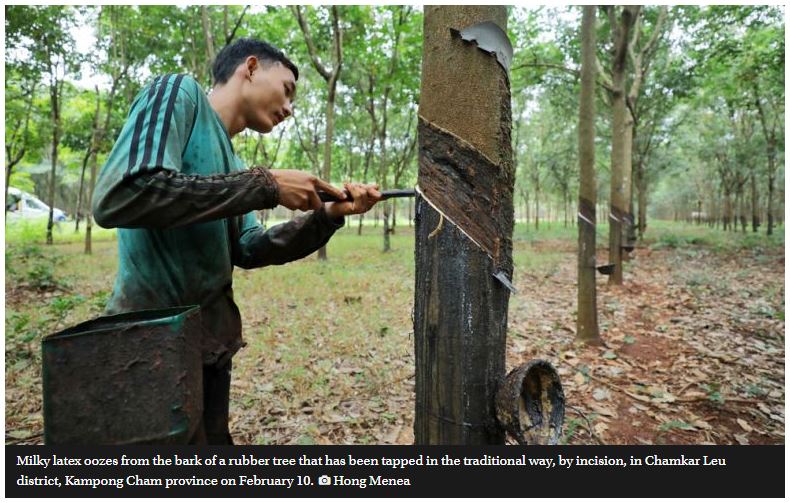Cambodia: Demand dip drives down int’l rubber sales by 9%
Cambodia netted more than $348 million from the export of rubber latex and wood in the first nine months of 2022, falling by nine per cent year-on-year due to downward pressure on global demand, especially from China and Europe, the latter of which has seen many of its markets upended by the fallout from armed conflict in Ukraine.
This is according to a report from the General Directorate of Rubber (GDR) under the Ministry of Agriculture, Forestry and Fisheries, obtained by The Post on October 20.
In the January-September period, Cambodia’s international sales of rubber latex came to 227,600 tonnes worth more than $345 million, which was up 727 tonnes (0.32 per cent) year-on-year, while those of rubber wood totalled 21,832 cubic metres, valued at over $3 million, the report said.
Explaining the drop in overall value, the GDR underlined that the average selling price of Cambodian rubber latex over the nine-month period was $1,517 per tonne, down by $148 or nine per cent year-on-year.
By comparison, the General Department of Customs and Excise (GDCE) has cited rubber exports for January-September at $272.8 million and those for the same period last year at 174,100 tonnes valued at $265.8 million, figures that are far lower than those suggested by the GDR.
Nonetheless, GDCE data suggest that on-year export value growth slowed down dramatically in the 2022 nine-month period to just 2.6 per cent, whereas the same interval in 2021 had seen 38.4 per cent and 72.3 per cent year-on-year increases in terms of tonnage and value, respectively.
GDR chief Him Aun suggested that Cambodia’s overall exports have recently been losing momentum due to the global economic crisis, a claim backed by GDCE figures, which indicate that September saw a 13.66 per cent dip from August, following a 21.69 per cent decline from July.
When asked about the on-year decrease in the value of Cambodia’s international rubber sales from January to September, he merely highlighted the Kingdom’s dependent position in the global export market of the commodity.
“The prices [of Cambodian rubber] fell due to the global economic crisis, low demand, inflation fears, the US interest rate hikes to tighten the circulation of dollars, the recovery situation, China’s continued lockdowns in part due to Covid-19, the Russo-Ukrainian war, and geopolitical impacts resulting from China and the US,” he told The Post on October 20.
Aun said that the main buyers of Cambodian rubber are China, Vietnam, Singapore, Malaysia, Japan, South Korea and the EU.
Similarly, Men Sopheak, CEO of rubber grower and exporter Sopheak Nika Investment Agro-Industrial Plants Co Ltd, told The Post that economic spillovers from the Ukraine conflict and the Taiwan issue are hurting demand and are at the very root of the falling global rubber prices.
“We know that the Chinese market alone accounts for 70-80 per cent of the world’s total demand, which has also been driven down by problems in Europe,” he explained.
Sopheak expressed hope for improvements in the Ukraine and Taiwan situations, paving the way for a recovery in global rubber demand. He also revealed that China buys “about 40 per cent” of all rubber produced in Cambodia, noting that official exports to the Chinese market must first pass through Vietnam.
“We wish [an end to] China’s economic downturn caused by its zero-Covid-19 policy and the real estate crisis. The Chinese government has slashed its key interest rate to boost its economy – prices for natural rubber may recover accordingly,” Sopheak speculated.
The GDR reports that as of 2021, Cambodia had 404,044ha dedicated to rubber production, with 310,193ha or 76.77 per cent mature and tapped for latex, which yielded 368,000 tonnes last year, or an average of just below 1,200kg per hectare. According to Aun, the area under rubber cultivation has not seen significant changes in the past “two or three years”.
Cambodian rubber latex and wood exports topped $611.77 million in 2021, climbing up from $482 million a year earlier. Broken down by category, 366,300 tonnes of natural rubber latex – or over 99 per cent of total production last year – accounted for $610.26 million, and 454 cubic metres of rubber wood clocked in at $1.52 million, the directorate reported.
Source: https://www.phnompenhpost.com/business/demand-dip-drives-down-intl-rubber-sales-9


 English
English




